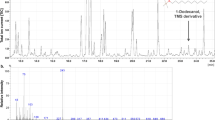Abstract
Maximum challenge exposure of Liposcelis bostrychophila to Beauveria bassiana, Paecilomyces fumosoroseus, Aspergillus parasiticus or Metarhizium anisopliae resulted in no more than 16% mortality. We investigated several of L. bostrychophila's cuticular lipids for possible contributions to its tolerance for entomopathogenic fungi. Saturated C14 and C16 fatty acids did not reduce the germination rates of B. bassiana or M. anisopliae conidia. Saturated C6 to C12 fatty acids that have not been identified in L. bostrychophila cuticular extracts significantly reduced germination, but the reduction was mitigated by the presence of stearamide. Cis-6-hexadecenal did not affect germination rates. Mycelial growth of either fungal species did not occur in the presence of caprylic acid, was reduced by the presence of lauric acid, and was not significantly affected by palmitic acid. Liposcelis bostrychophila is the only insect for which fatty acid amides have been identified as cuticular components. Stearamide, its major fatty amide, did not reduce germination of B. bassiana or M. anisopliae conidia or growth of their mycelia. Adhesion of conidia to stearamide preparations did not differ significantly from adhesion to the cuticle of L. bostrychophila. Pretreatment of a beetle known to be fungus-susceptible, larval Oryzaephilus surinamensis, with stearamide significantly decreased adhesion of B. bassiana or M. anisopliae conidia to their cuticles. This evidence indicates that cuticular fatty amides may contribute to L. bostrychophila's tolerance for entomopathogenic fungi by decreasing hydrophobicity and static charge, thereby reducing conidial adhesion.
Similar content being viewed by others
References
Badonnel A. Contribution a l'étude de la faune du Mozambi-que. Voyage de M.P. Lesne (1928–1928). 4e note. Copéognathes. Ann Sci Nat (Zool) 1931; 14: 229–260
Turner BD. Forming a clearer view of L. bostrychophilus. Environ Health 1987; 95: 9–13.
Broadhead E. The infestion of warehouses and ships' holds by psocids in Britain. Entomol Monthly Mag 1954; 90: 103–105.
Turner BD. Liposcelis bostrychophila (Psocoptera: Liposcelidae), a stored food pest in the UK. Int J Pest Manage 1994; 40: 179–190.
Howard RW, Lord JC. Cuticular lipids of the stored food pest, Liposcelis bostrychophila: hydrocarbons, aldehydes, fatty acids and fatty amides. 2003. J Chem Ecol 2003; 29: 597–609.
Cooper I, Tice PA. Migration studies on fatty acid amide slip additives from plastics into food simulants. Food Additives Contaminants. 1995; 12: 235–244.
Boucias DG, Pendland JC, Latge JP. Nonspecific factors in-volved in attachment of entomopathogenic Deuteromycetes to host insect cuticle. Appl Environ Microbiol 1988; 54: 1795–805.
Terhune BT, Hoch HC. Substrate hydrophobicity and adherence of Uromyces uredospores and germlings. Exp Mycol 1993; 17: 241–252.
Leong ECW, Ho SH. Techniques in the culturing and handling of Liposcelis entomophilus (Enderlein) (Psocoptera: Liposcelidae). J Stored Prod Res 1990; 26: 67–70.
Gerhart DJ, Rittschof D, Hooper IR, Eisenman K, Meyer AE, Baier, RE, Young C. Rapid and inexpensive quantification of the combined polar components of surface wettability: application to biofouling. Biofouling 1992; 5: 251–259.
Motulsky HJ, Searle P. The InStat Guide to Choosing and Interpreting Statistical Tests. San Diego: GraphPad Software; 1990.
Knülle W, Spadafora RR. Water vapor sorption and humidity relationships in Liposcelis (Insecta: Psocoptera). J Stored Prod Res 1969; 5: 49–55.
Mills JT, Sinha RN, Demianyk CJ. Feeding and multiplication of a psocid, Liposcelis bostrychophilus Badonnel (Psocoptera: Liposcelidae), on wheat, grain screening, and fungi. J Econ Entomol 1992; 85: 1453–1462.
Koidsumi K. Antifungal action of cuticular lipids in insects. J Insect Physiol 1957; 1: 40–51.
Saito T, Aoki J. Toxicity of free fatty acids on the larval surfaces of two Lepidopterous insects towards Beauveria bas-siana (Bals.) Vuill. and Paecilomyces fumoso-roseus (Wize) Brown and Smith (Deuteromycetes: Moniliales). Appl Entomol Zool 1983; 18: 225–233.
Smith RJ, Grula EA. Toxic components on the larval surface of the corn earworm (Heliothis zea) and their effects on germination and growth of Beauveria bassiana. J Invertebr Pathol 1982; 39: 15–22.
Sosa-Gomez, DR Boucias DG, Nation JL. Attachment of Metarhizium anisopliae to the southern green stinkbug Nezara viridula cuticle and fungistatic effect of cuticular lipids and aldehydes. J Invertebr Pathol 1997; 69: 31–39.
Fargues J. Adhesion of the fungal spore to the insect cuticle. In: Roberts DW, Aist JR, eds. Infection processes of fungi. New York: Rockefeller Foundation; 1984: 90–110.
Lord JC. Response of the wasp Cephalonomia tarsalis (Hymenoptera: Bethylidae) to Beauveria bassiana (Hyphomy-cetes: Moniliales) as free conidia or infection in its host, the sawtoothed grain beetle, Oryzaephilus surinamensis (Cole-optera: Silvanidae). Biol Control 2001; 21: 300–304.
Howard RW, Howard CD, Colquhoun S. Ontogenic and environmentally induced changes in cuticular hydrocarbons of Oryzaephilus surinamensis (Coleoptera: Cucujidae). Ann En-tomol Soc Am 1995; 88: 485–495.
Author information
Authors and Affiliations
Rights and permissions
About this article
Cite this article
Lord, J.C., Howard, R.W. A Proposed Role for the Cuticular Fatty Amides of Liposcelis bostrychophila (Psocoptera: Liposcelidae) in Preventing Adhesion of Entomopathogenic Fungi with Dry-conidia. Mycopathologia 158, 211–217 (2004). https://doi.org/10.1023/B:MYCO.0000041837.29478.78
Issue Date:
DOI: https://doi.org/10.1023/B:MYCO.0000041837.29478.78




